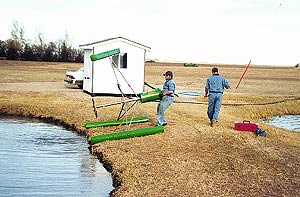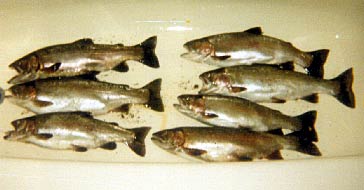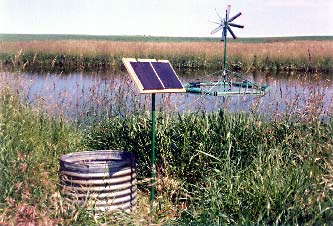 |

 |
Frequently Asked Questions |
 |
|
- What is it and what does it do?
- Will you guarantee that it will work?
- If it doesn't work can I get my money back?
- You aren't blowing any air in. How does it get air
into the liquid?
- Would this be as good as air-pumpers/injection for
putting oxygen in the liquid?
- What does it do for salt (minerals) or pH?
- Won't it make a lagoon smell worse if you mix it up
like that?
- How would it remove the odour from my lagoon?
- Would I still have to agitate (slurry) my sewage
lagoon before I pump it out?
- How could it remove the sludge in my sewage lagoon?
- How long would it take to remove the sludge in my
sewage lagoon?
- Would I lose the fertilizer value using this liquid
composting process in my livestock lagoon?
- Wouldn't this be hard on the land if I apply it to
the same field each year?
- Can you get enough oxygen in the lagoon with that
impeller to remove the odour?
- Would the machine be good for fish?
- I've got a pond that we use for the
house. Would it do anything for that smelly water in the winter and
what would it do for the algae?
- What is it and what does it do?
The Little River Pond Mill® circulator is a biogeochemical (BGC) remediation
facilitator/biological stimulator. Big words! In simple terms, it is a machine that
circulates the water and promotes the natural life cycle processes
(nutrients, oxygen, and aquatic animals, plants, and insects) to
function more effectively.
-
Will you guarantee that it will work?
The machine will do what it is supposed to do - circulate liquid and
promote passive re-aeration at the surface (air-water interface). The
circulation that the machine creates transfers oxygen throughout the
body of liquid. If you have adequate machines numbers, if you have an
adequate retention time, if all the biotic and abiotic factors
required are available, you should be another happy customer for your
application.
-
If it doesn't work can I get my money back?
If the machine isn't working we can provide repair personnel. If the
remediation system isn't functioning we have
professional personnel that can
assist in trouble-shooting so that you achieve your desired result.
 Machine Installation on a Pond
Machine Installation on a Pond
Assiniboia, SK, Canada
-
You aren't blowing any air in. How does it get air into the
liquid?
Oxygen is being input in two ways.
1. The first pathway involves passive transfer of oxygen at the
liquid-air interface via a
recirculating toroidal vortex bringing liquid to the
surface where it radially flows across the surface. Oxygen transfer at the
surface is close to 100% efficient when compared with bubble systems
that have efficiencies ranging from 5 - 40% with micro-bubble systems
having the highest efficiency of the air-injection systems. The
smaller the bubble size – the greater the oxygen transfer
efficiency; the smallest bubble size is at the molecular level.
2. The second pathway involves promoting active transfer of oxygen through
input by photosynthetic bacteria and algae living within the liquid.
Remember, the machine promotes a healthy aquatic environment and a
balance of organisms, including algae, cyanobacteria and aquatic
vegetation.
-
Would this be as good as air-pumpers/injection for putting oxygen
in the liquid?
It would be as good or better. Air injection systems do not have one
crucial component in the aeration process – the circulation. The
circulation component is vital for ensuring oxygen is circulated
throughout the lagoon, container, pond or lake. The oxygenated water is
circulated throughout the entire pond via the
recirculating toroidal vortex created
by the impeller. It should be noted that with an optimum flow velocity
of about 9 m3/s (7.1 million gallons/h) and an effective radius
of at least 14 m (46 feet) (depends on the
liquid type, temperature, etc.), there is substantial
radial movement of water at the
liquid-air interface.
Air-injection systems typically have a slow, negligible or ineffective
circulation current created by the movement of bubbles to the surface.
Some of the most efficient air bubble systems have
seen a theoretical circulation of 4.2 million litres/24 h (1 million
gallons/24 h) when compared to
the
Little River Pond Mill® circulator
which exceeds 7
times that value per hour. Unless the oxygen and the
nutrients are being adequately circulated how are the non-mobile
aquatic organisms going to effectively survive?
Many of the air pumper/injection systems require addition of chemicals
to assist in binding up of nutrient and suspended solids components.
The
Little River Pond Mill® circulator
promotes alteration of the
chemical conditions within the liquid through natural biogeochemical
processes and addition of chemicals is not recommended since it
typically interferes with, and in many instances
destroys, the natural processes we are trying to
promote.
In some wastewater treatment processes, use of the
Little River Pond Mill® circulator
along
with the chemicals enhances the chemical addition and a reduction in
quantity of chemical use due to improved efficiency
has been observed.
Nutrient (if desired) and solids removal can be effectively achieved by
enhancement of the biological and geochemical activity within the
water through use of the LRPM Aerobic Remediation System - all without
the use of potentially harmful chemicals
-
What does it do for salt (minerals) or pH?
The action of the Little River Pond Mill® circulator has been shown to alter pH
(increase or decrease) as a result of various
naturally occurring chemical interactions, however
the machine action cannot eliminate salts, i.e. calcium, magnesium,
potassium, sodium, from the ecosystem. Aquatic species remove mineral
salts for metabolic processes, and others may become bound (permanent
and/or temporary) to mineral and/or clay surfaces; however, they will
ultimately remain within the ecosystem unless removed by organisms or
through various chemical processes.
-
Won't it make a lagoon smell worse if you mix it up like that?
Liquid manure/sewage and waste
water lagoons smell as a result of
gases produced by anaerobic (without the presence of oxygen)
decomposition of organic substances or the release of odorous volatile
intermediates. The introduction of oxygen and circulation promotes the
creation of bioflocs and/or biofilms (BAF – biologically active
filtration) that degrade the organics (essentially they eat them)
within the lagoon - aerobically. Aerobic decomposition is more
complete than anaerobic and occurs without the production of noxious
odours and potentially detrimental gases.
-
How would it remove the
odour from my lagoon?
The Little River Pond Mill® circulator itself doesn't remove the odour. The
circulation created by the circulator assists in initially venting
some
stored gases and promotes a recycling of the volatile gases within the
system. It also assists in aerobic decomposition of organics, which
means the odours and gases aren't being created in the first place.
-
Would I still have to agitate (slurry) my sewage lagoon before I
pump it out?
Assuming you have adequate machine numbers to handle the workload
(with respect to your retention time and nutrient/organic loading),
and assuming environmental conditions haven't slowed the remediation
process signficantly,
there should be no requirement for agitation of the lagoon prior to
pumping it out. The microorganisms should have digested (eaten) down
the solids components to the equivalent of a liquid fertilizer
solution.
-
How could it remove the sludge in my sewage lagoon?
The machine itself doesn't remove the sludge. The machine promotes the
biological processes (aerobic liquid composting or BAF – biologically
active filtration) through which the solids are digested (eaten) down.
The microorganisms decompose (digest) the solids and utilize the
carbon (for energy) and the nutrients in the sewage to grow and
increase their numbers in much the same manner that our bodies utilize
the food we eat.
-
How long would it take to remove the sludge in my sewage lagoon?
This is almost like asking how long is a string. The time element
depends on a number of factors including organic/nutrient loading,
initial depth of sludge, number of machines used, retention time,
presence of chemicals that may slow the remediation process, i.e.
antibacterials, ..., environmental factors such as temperature, just to
name a few. Some of the factors involved in reducing remediation time
include a large surface area (for oxygen transfer), presence of
optimum remediation temperatures (e.g. 20-45 °C), utilization of adequate
or excess machine numbers for your desired retention time – just to
name a few.
-
Would I lose the fertilizer value using this liquid composting
process in my livestock lagoon?
The final fertilizer value will depend upon the nutrient content of
the manure going through the liquid composting process and how soon
you get the lagoon working more aerobically. Aerobic liquid composting promotes
mineralization of nutrients and thus stabilization of those nutrients.
Volatile nutrients such as nitrogen and sulfur, which would typically
vent off either in the lagoon or during land application, will become
stable and will remain in solution using this process. The final
fertigation (liquid fertilizer solution) liquid is homogenous and
makes nutrient testing fast, easy and reliable. Nutrient ratios of the
raw manure (C:N:P:S) will also affect the final nutrient content;
microbes will also temporarily utilize some of the nutrients so some
nutrients will be stored in their bodies.
-
Wouldn't this be hard on the land if I apply it to the same field
each year?
Let me rephrase this question. Would application of this remediated
liquid burn my crop or contaminate surface or ground water?
As with any proper nutrient management plan, a farmer/producer should know what
nutrients are in the soil, what is required by the crop in any given
year, and what the fertilizer value is of the fertilizer solution
being applied. In this case, the liquid is known as fertigation liquid
since the remediated liquid manure contains nutrients that will be
used to fertilize a crop/land typically via irrigation equipment. The
fertigation liquid and the soil should be tested prior to fertigating
to insure that nutrient excesses or deficiencies will not be a problem
to crop growth.
With respect to ground water contamination - proper irrigation and
nutrient management practices should prevent this potentially serious
problem.
-
Can you get enough oxygen in the lagoon with that impeller to
remove the odour?
Assuming there are adequate machine numbers and
adequate surface area per machine required, anaerobic decomposition
should not be occurring and therefore the production of odours should
not be a problem.
-
Would the machine be good for fish?
Since the machine promotes both passive and active aeration in surface
waters, and since many fish die as a result of oxygen deprivation
during mid to late winter and immediately following algae
and cyanobacteria blooms in
the summer, the machine is very good for fish. The machine enhances
the natural cycling processes within the surface water thereby
increasing natural diversity, increasing availability of both food and
oxygen, and in general - making the environment that the fish live in
more conducive to growth and reproduction. Because the machine
promotes degradation of organics and synthetics, the machine may
promote the degradation of chemicals/hormones,... that have been
proven harmful to fish reproduction and growth processes.
 2 - 3 year old Rainbow Trout
2 - 3 year old Rainbow Trout
Raised in a 1.8 million gallon pond
Assiniboia, SK, Canada
-
I've got a pond that we use for the house. Would it do anything for
that smelly water in the winter and what would it do for the algae?
The machine will assist in reversing and preventing both conditions.
Smelly water in winter is a result of anaerobic gases production. The
gases are produced as a result of anaerobic (without the presence of
oxygen) decomposition of organics (i.e. leaf matter) in the pond by
microorganisms. Because the machine is promoting
both passive and active aeration, the pond should not become anaerobic,
even during winter, and therefore result in odourless water throughout
the winter months. One often over-looked point in good quality water is
the condition of the well beside many dugouts/ponds. The well can
become quite stagnant and should be aerated to keep water quality good.
We have recently developed a solar-powered well aerator to assist in
maintaining a clean well and water transmission lines.
 Well Aerator
Well Aerator
Assiniboia, SK, Canada
Algae and cyanobacteria blooms on your pond during summer months are a result of
eutrophication. The algae and cyanobacteria feed off the nutrient rich waters and because
there are limited grazers and competition for the nutrients, the algae
and cyanobacteria become overpopulated. Some algae
and cyanobacteria growth is necessary in any properly
functioning aquatic ecosystem; however, algae
and cyanobacteria blooms indicate that the
system is not functioning properly; there is a missing link. In most
cases, this missing link is additional oxygen and circulation which
promote the growth of other organisms and assists in
tying up of nutrients such as phosphorus. The added oxygen replaces the
oxygen that microorganisms use in decomposing dead algae and other
plants and animals. The circulation ensures that both nutrients and
oxygen are circulated throughout the pond so that the whole pond
functions properly. Both the oxygen and the circulation will assist the
pond in returning to a fresher state. Remember the ponds in the old
days when we used to have frogs and lots of different types of minnows,
bugs, and water fowl? There was a diversity of both plants and animals.
The machine will assist your pond in returning to a healthy state once
again.
|
|
 |